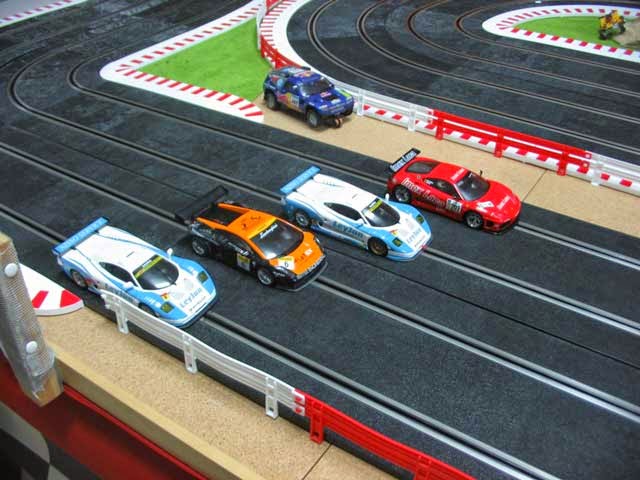 |
| Slot Car Racing |
Electronic hobbyists and enthusiasts usually loves to build and play with toy cars. If you are one of them, here is a circuit which can control the Slot cars. The “Slot cars” use a slot in the track and a pin under the car to help guide them around the track. They usually come with two cars. This Slot car controller circuit allows two users to adjust the speed to the maximum without the cars flying off the track when going around the curves. Also the “boost” button allows for maximum acceleration and power down the straight-a-ways.
CIRCUIT DIAGRAM:
WORKING OF SLOT CAR CONTROLLER CIRCUIT:
The above Race car speed control circuit consists of two separate units. Power Unit – This section provides the power for the entire circuit & Control Unit – This section controls the motor speed.
POWER UNIT:
The power unit houses: switch S3(On/Off), F1 fuse, T1 12VAC-2A transformer, D1-4 diodes forms bridge rectifier and C1 filter cap. Q1, D5, D6, for channel “A” motor control. Q2, D7, D8 for channel B motor control and LED D9 is used to indicate the power. 2 – 3-pin headers CN1-3, CN4-6 used to connect the channel “A” and “B” controllers. I recommend using four wires (like in a ribbon cable) to connect each controller to the main power unit.
CONTROLLER UNIT:
For purposes of this discussion, refer to channel “A” portion of the schematic. The circuit is intend to be used with any DC power supply from 9V to 30V. That is why the D6 gate clamping is used for higher voltages to protect the IRFZ48 MOSFET, (IRFZ44’s would also be a good choice). R11 in parallel with D6 makes sure that Q1 is turned OFF when the controller is not connected. And D5 provides flyback protection for the MOSFET for the inductive motor load.
The heart of the circuit is the LM358 dual op-amp. U1A, R1, R3, form a V/2 divider for the oscillator reference divider network, R6, R7, R8, allows the duty cycle to work with any DC supply from 9V to 30V and provide the same 0 to 100% duty cycle over the full range of speed control pot, R7. U1A here is a triangle wave oscillator. R2 provides positive feedback to the plus input of U1A (U1Ain+).
The amount of switching hysteresis is effectively determined by the resistance of R1//R3 and R2, When the output of U1A switches from low to high, the input of U1Ain+ switches above the input of U1Ain-. This makes the output of U1A remain high. C2 begins to charge through resister R5. When U1Ain- goes higher than U1Ain+, the output of U1A goes low. U1Ain+ is pulled below U1Ain- which makes the output of U1A remain low. C2 begins to discharge through R5. When U1Ain- goes below u1Ain+, the output of U1A again goes high. Thus U1A oscillates.
The junction of U1Ain-, R5, and C2 ramps up and down in a triangle shaped waveform. U1B compares the voltage at C2, R5 junction to a reference voltage provided by the divider network of R6, R8, and speed control R7. The values of R6 and R8 are chosen so that the voltage span across R7, is greater than the amplitude of the triangle wave at the junction of C2, R5. When the junction voltage is less than the reference, the output of U1B is high which turns ON Q1. When the junction voltage is greater than the reference, the output of U1B is low which turns OFF Q1. In this case the V+ screw terminal will source the power to the motor and Power MOSFET’s will provide PWM ground for each channels.
As the reference voltage changes, the duty cycle output of U1B goes from 0% to 100%. Resistor R9 and the turbo switch S1 provide a pull-up voltage to the reference which makes U1B output high and turns ON Q1, to provide a 100% duty cycle hard ON for the Turbo boost down the straight-a-ways.
NOTE:
- The Resistors R7 and R19 provides speed control for Channel A and B while Switch S1 and S2 is for activating turbo.
- The four screw terminals shown in the schematic could be reduced to three if the track has two of the common rails tied together. Therefore I provided four in case each track had it’s own individual (two) screw connectors
- This circuit also proves effective for light dimming or any other type of PWM 0% to 100% control.

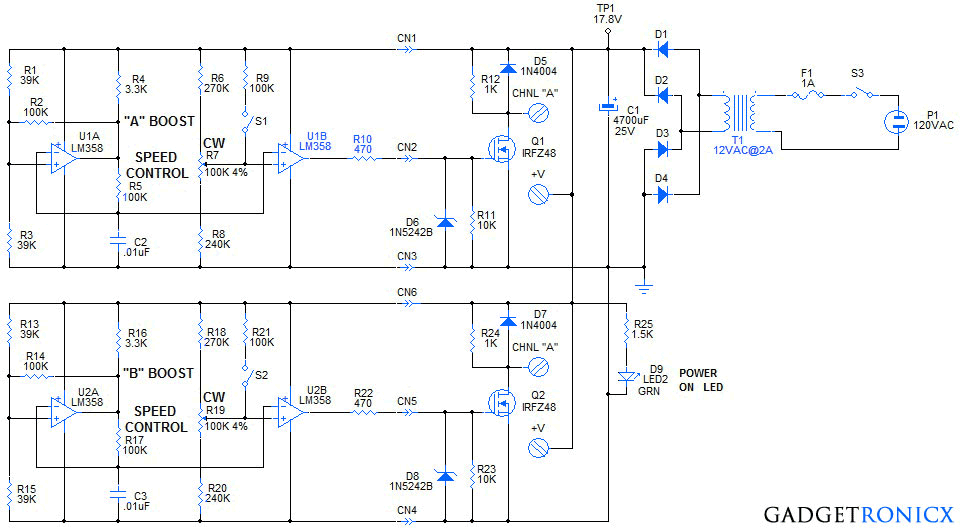

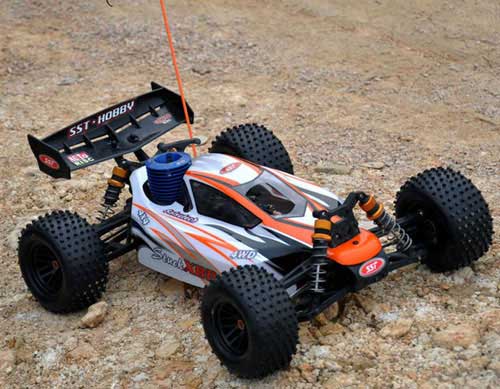
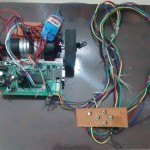
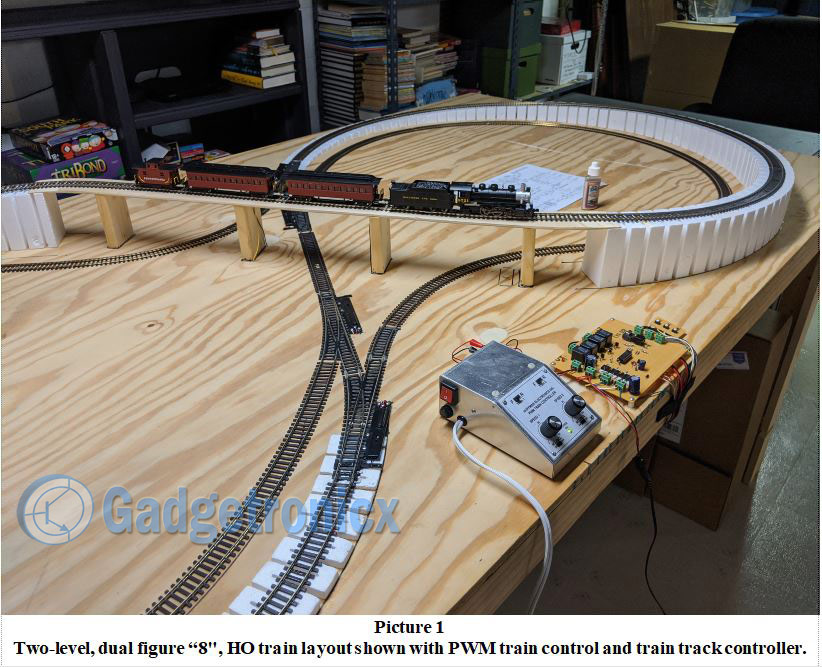

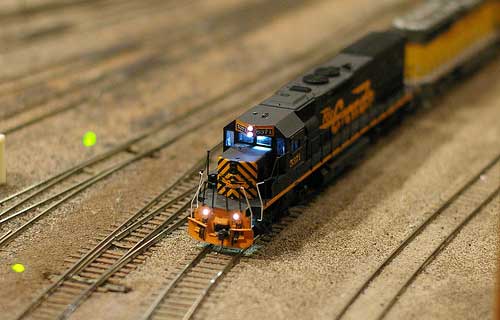
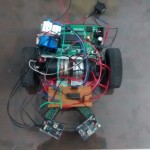
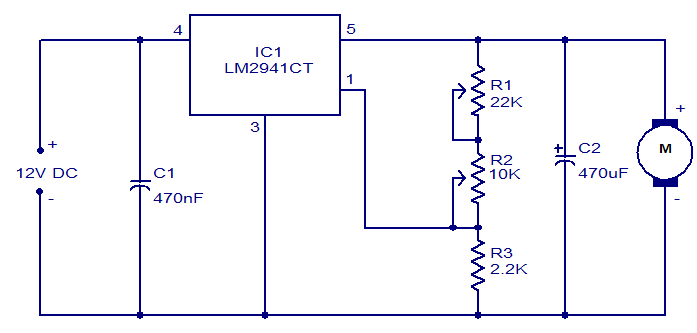
Aravind, To use the controller with a TX, connect a 3.3K pull-up resistor from the output of U1B to +Vsupp. This will provide a .4V (low) to +Vsupp (high), PWM ouptut. Change the 470 ohm output resistor to 1K and connect it to the modulator input of the TX. You may need to use a resistive divider network to reduce the PWM amplitude going to the the TX input. The output of the RX needs to go from [0V – .5V, (low)] to [5V (minimum) – +Vsupp (10V maximum) (high)]. Add a 1K resistor in series with the gate of the IRFZ44 MOSFET. This will limit current and allow the gate clamp to protect the MOSFET from overvoltage. Connect the RX output to the gate input 1K resistor. The MOSFET needs a minimum of 5V on the gate to be ON. The clamp limits the gate voltage to 9V maximum. This will allow you operate your slot car remotely. Hope this answers your question. Regrads, Ron H.
thank you for helping me out sir cant wait to try it out…..
great circuit sir.. now i need to use this speed controller circuit to a remote controlled car….suggest the modifications i need to make sir…thanks in advance
Aravind, You notice that each controller “A” and “B” are connected to the power unit via a three wire cable. It is not intended for remote applications. Remote controlled cars (RF remote) usually have a speed dial or joy stick to set the speed. You could modify your transmitter to have a push-button that would preempt the speed setting and tell the transmitter that the speed setting is maximum. Since I don’t know your particular system, I can’t help you much more. Hope this helps you. Ron H.
sir my idea is to use the section in your controller unit and feed the output pwm pulse to a rf TX and receive it through a RX and then use it to control motor…will it work sir??
Yes. If you use the ON – OFF logic levels to send the TX data and then use the RX 1 – 0 data to drive the MOSFETS it should work just fine. Make sure the RX output level is 5 volts or more to ensure proper turn ON of the IRFZ44 MOSFETS. Good luck. Let me know how it turns out.